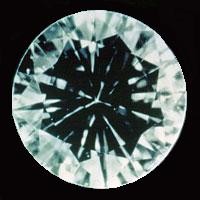The nailhead effect refers to an unattractive black or dark shadow that appears under the center of a round brilliant cut diamond when its pavilion (lower portion) is too deep. This phenomenon makes the diamond look dull and lifeless, significantly reducing its brilliance and sparkle.
What Causes the Nailhead Effect?
Excessive Pavilion Depth
When a diamond’s pavilion is too deep, light entering through the crown (top portion) does not reflect properly.
Instead of bouncing back to the viewer’s eye, the light leaks out through the sides or bottom, creating a dark or black appearance in the center.
Reflection of the Table Facet
The dark shadow is often a reflection of the diamond’s table (the large flat facet on top) due to improper light return.
Instead of sparkling, the center appears dull, almost like a black “nailhead” at the heart of the diamond.
Poor Cut Proportions
Diamonds with incorrect depth-to-table ratios or poor symmetry are prone to the nailhead effect.
Ideal cut proportions ensure maximum brilliance by optimizing light reflection and refraction.
How to Avoid the Nailhead Effect?
Choose an Ideal-Cut Diamond:
Look for excellent or ideal cut grades, as these ensure proper pavilion depth and light performance.
Check Pavilion Angle:
A well-cut round brilliant diamond should have a pavilion depth of around 42.5%–43.5% of the total depth.
Observe the Diamond Under Different Lighting:
Rotate the diamond and view it under various lighting conditions to check for unwanted dark areas.
Get a Professional Grading Report:
Certification from laboratories like DCLA, GIA, or AGS will help verify the diamond’s proportions and cut quality.
Nailhead vs. Fish-Eye Effect
Nailhead Effect: Occurs when the pavilion is too deep, creating a dark shadow in the center.
Fish-Eye Effect: Happens when the pavilion is too shallow, causing an unattractive white or gray ring reflection inside the diamond.

